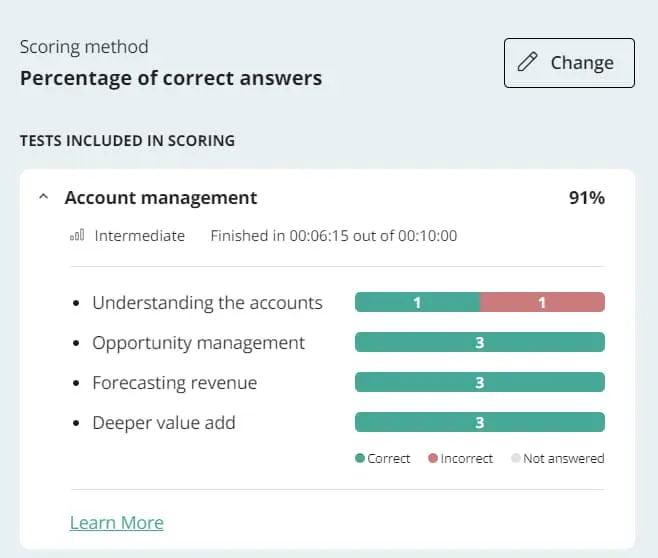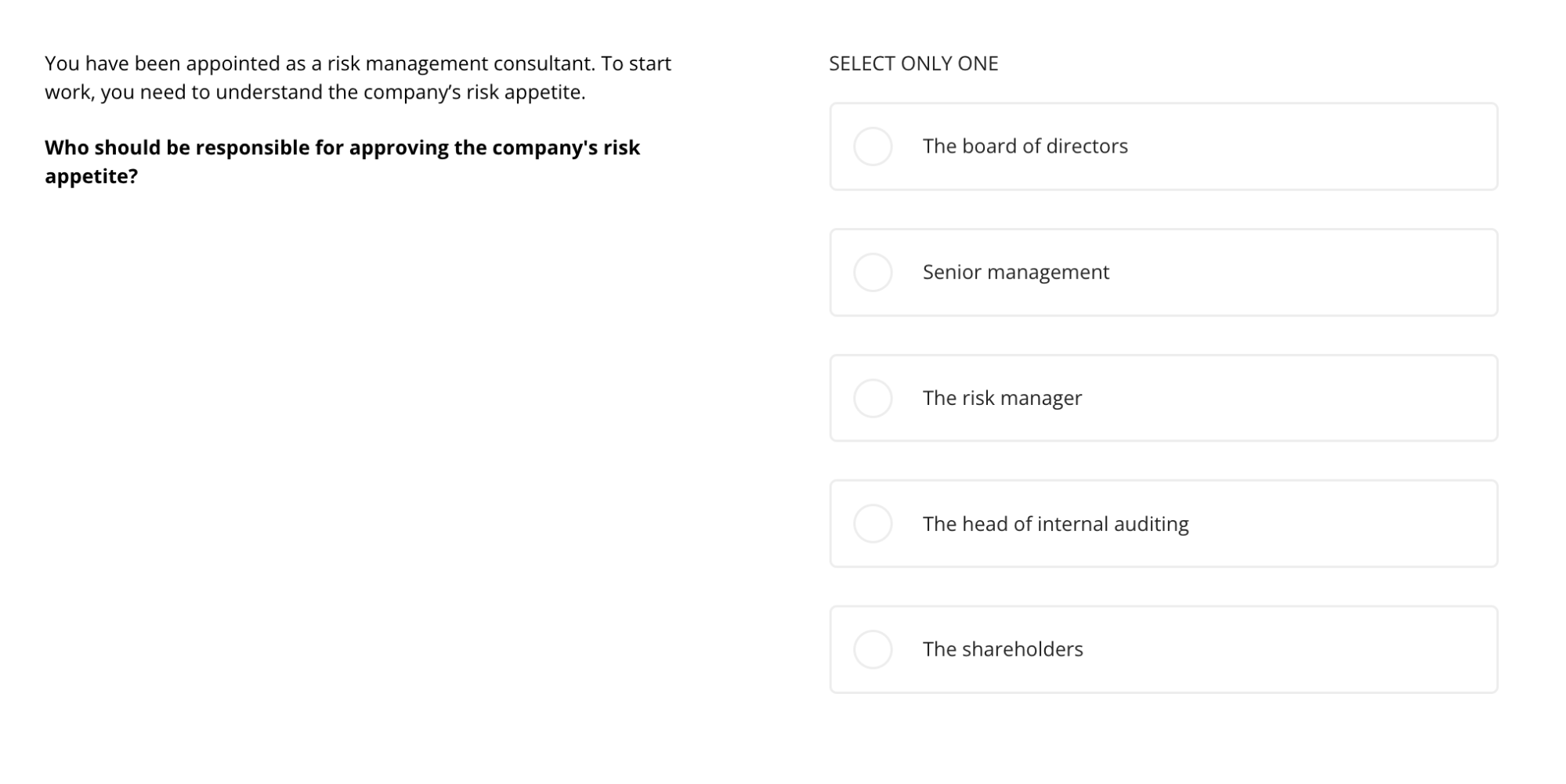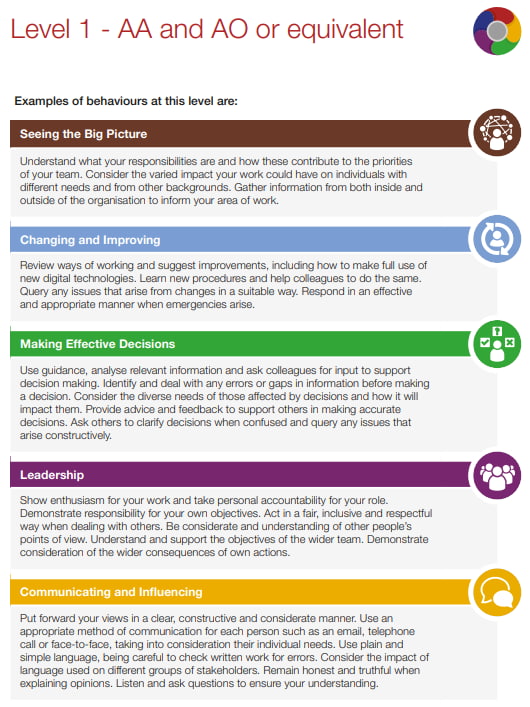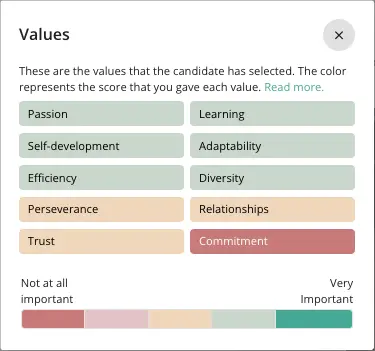Knowing how to develop a talent strategy to serve your organizational goals is an invaluable HR management skill.
Do it right and you can access benefits from improved retention to an uplift in revenue.
Do it wrong, and you risk creating confusion in your workforce and company culture.
To ensure your talent strategy helps you meet and exceed your organizational goals, we’ve put together a nine-step guide to developing a talent management strategy. We also include best practices for building a talent strategy and examples from real businesses.
Table of contents
- What is a talent strategy?
- Why is a talent strategy important? 5 benefits of a comprehensive talent management strategy
- How to develop a talent strategy: A 9-step guide
- 5 best practices for building the best talent management strategy
- 3 talent management strategy examples
- Create a data-driven talent strategy using skills testing
- Talent strategy FAQs
What is a talent strategy?
A talent management strategy is an organization’s plan for how to attract, recruit, engage, retain, and develop talent with the skills to meet and exceed its organizational goals. The process of developing the right talent management strategy encompasses:
Workforce planning: Continually identifying the skills missing or needed in your workforce to meet your business goals
Workforce assessment: Evaluating the skills present in your workforce to spot areas for development or recruitment
Talent acquisition strategy: Hiring new talent to fill gaps or strengthen teams
Talent development strategy: Strengthening or supplementing employees’ existing skills to further their careers and meet your business goals
Talent retention: Incentivizing employees to stay on board by providing holistic support
Succession planning: Identifying internal candidates to fill business-critical positions before those positions are vacated
Why is a talent strategy important? 5 benefits of a comprehensive talent management strategy
Creating a talent management strategy aligns your human resource activities with your overall strategic priorities to ensure your team is working toward the same goals.
This has several benefits:
It helps you prioritize which trends to follow – for example, employee retention trends like upward feedback – enabling you to adapt to a changing workforce while maintaining efficiency
It improves your employee retention rate, lowering the cost of high turnover rates
It improves employee engagement and company culture
It helps you spot and nurture future leaders, guaranteeing business continuity
It ensures you have the necessary skills to meet your current targets – and helps you prepare to move beyond these in the future
How to develop a talent strategy: A 9-step guide
You’ve seen what talent management strategies can do. Now it’s time to access those benefits in your business.
Here’s how to develop a talent strategy that stimulates organizational growth opportunities.
9-step guide to developing talent management strategies: Summary
If you’re already halfway through creating a talent management process and want to know what your next move should be, here’s a quick summary.
Talent management strategy steps | Summary |
1. Identify the overall business strategy and culture | Outline key business goals and establish success metrics for each |
2. Conduct a skills gap analysis | Test mission-critical team members for essential skills and use the information to guide your talent strategy |
3. Develop an internal mobility plan | Create a talent mobility strategy to promote employees internally, such as by using an internal talent marketplace |
4. Create a recruitment plan | Forecast your skills needs for the year ahead based on data from your skills gap analysis and your strategic goals |
5. Design a solid onboarding process | Use insights from skills testing to target weak areas of new recruits’ skills during onboarding |
6. Build performance and learning and development programs | Tailor professional development plans to each employee using skills test data to strengthen their skill sets |
7. Establish a retention plan | Create a dedicated employee retention plan (for example, with employee recognition programs) to improve employee experience |
8. Finetune your succession planning efforts | Conduct job analyses for important roles and put processes in place to reassess new hires |
9. Monitor your performance and make improvements | Continually evaluate the success of your talent management strategies based on the key metrics identified in step one |
1. Identify the overall business strategy and culture
Creating a talent management strategy that works for your business first requires you define what your priorities are, such as:
Diversifying your product offering
Expanding into new geographic markets
Becoming an industry leader in sustainability
This helps you shape a company culture that serves these goals and informs the strategies you use to attract, retain, and develop talent.
For example, if your priority is boosting innovation in your product development teams, you can design your talent development strategies to nurture innovation – for instance, by providing employees with mentoring and skills training around agile development.
This in turn attracts candidates motivated to meet these goals: According to research by TrustRadius, 86% of jobseekers say company culture is important to them when choosing a new role.
Crucially, you should determine key metrics for your priorities so you can measure the impact of your talent management strategies on your goals.
2. Conduct a skills gap analysis
Next, tailor your talent strategy framework to your needs by conducting a skills gap analysis.
This is when you use talent assessments to test the skills of workers in mission-critical teams to identify weak areas and gaps.
There might be more missing skills than you think. Gartner's research suggests that almost 60% of the workforce needs new skills to do an effective job.
Using TestGorilla, you could test account managers for key skills like opportunity management and forecasting revenue and see which skill areas they were weakest in:
The results of your skills gap analysis could then dictate your learning and development strategy and your recruitment plan. You could even use the same tests during skills-based hiring to discover people to plug the gaps.
To try it out yourself, register for our free forever plan and start analyzing your talent gaps.
3. Develop an internal mobility plan
Expanding skills testing across your workforce could reveal opportunities to plug skills gaps with internal recruitment.
This is not only cost-effective but hugely beneficial for employee retention.
Research shows that 70% of employees who are promoted within three years of hiring stay on board, as do 62% of employees who make lateral moves. Those who do neither have just a 45% chance of remaining with their employers.
Launch your talent mobility strategy by:
Implementing regular skills testing
Inputting skills test data to an internal talent marketplace
Giving your employees the freedom to stretch their skills outside of their direct job description, similar to Google’s “20% time”
4. Create a recruitment plan
A recruitment plan is a forecast of your recruitment needs for the year ahead. This helps you proactively recruit both internally and externally to meet strategic priorities, instead of scrambling when a need opens up.
For example, you might be planning to launch a huge new digital product in a year. Skills testing shows you have the project management and web development skills you need to plan the project, but to execute it, you need more development and marketing power.
With this in mind, you can create a recruitment process that factors in which skills will become necessary at which points in the roadmap, as well as the time it takes to onboard each employee.
Your recruitment or hiring plan should also include:
Results and insights from talent assessments and skills gap analyses about which skills are needed
A clear outline of your hiring process so your team is on the same page
Continuous processes for forecasting and monitoring the supply and demand of important skills
A talent sourcing strategy to maintain a steady stream of qualified candidates
Innovative strategies to attract quality talent while standing out as an employer
A talent pipeline composed of past candidates and boomerang employees whose skills data lives in your TestGorilla database
5. Design a solid onboarding process
Don’t underestimate the importance of a good onboarding process.
Employees who experience highly effective onboarding are 18 times more likely to feel committed to their employers.
To help new employees hit the ground running, use insights from their pre-employment skills tests to inform your approach.
For example, if a recruit has exceeded your benchmarks for four out of five of the key skill areas for the role but fallen short on one of them, you could include skills training in this area as part of their onboarding plan.
This ensures they don’t start the job with a deficit of skills and catch up to the rest of the team as soon as possible. It also creates a strong first impression of you as a supportive employer, which benefits retention.
Skills testing doesn’t only help you decide what onboarding to provide; it can also inform how you provide it.
Researchers from Offenburg University of Applied Sciences found that people who demonstrate agreeableness and openness in the OCEAN (“Big Five”) personality test prefer gamified onboarding.
If this is available as part of your onboarding software, you could encourage these employees to try it.
6. Build performance and learning and development programs
Build on the skills you’ve identified in your workforce with performance management programs and a strong talent development strategy. This should include initiatives like upskilling opportunities and creating professional development plans for each employee.
The results could be massive: PwC found that more than 90% of chief executive officers who implement upskilling programs see increased productivity, talent acquisition and retention, and resilience among workers.
Again, it’s essential to use skills testing to tailor your approach here. Studies show organizations that align their HR processes with the skills needs of their employees boost engagement by 50%, halve training and development costs, and raise productivity by 40%.
7. Establish a retention plan
Many of the talent management strategies we’ve named already double as employee retention strategies.
However, you should also consider implementing dedicated employee retention plans, such as employee recognition programs.
When employees receive recognition at work, they’re unlikely to look for a job in the next six months.
It’s important to go beyond paying lip service to employees. Your employee recognition programs should address fundamental areas of employee satisfaction like pay structure and benefits.
Indeed, Lever's research shows that the biggest motivator for employees to stay in their jobs is salary and potential bonuses.
8. Finetune your succession planning efforts
Succession planning refers to the practice of anticipating changes in business-critical roles and having candidates lined up should an unexpected change occur.
This could include voluntary turnover but also situations like a sudden health emergency or an employee’s partner being relocated.
A strong succession planning strategy ensures business continuity and saves your organization money and stress.
To create a strategic plan:
Conduct job analyses for important roles, paying particular attention to leadership positions and leadership development
Consider whether an internal or external hire would be better
Routinely reassess externally appointed candidates who replace senior staff to ensure you’ve made the right decision
9. Monitor your performance and make improvements
Building a talent strategy is not the kind of process you can “set and forget.” It requires constant updates as the business grows, the market changes and technology evolves.
One example is your recruitment strategy. Data-driven recruiting and talent management strategies require continuous testing and fine-tuning based on the key metrics you identified in step one.
Let’s say your strategic goal was to expand into new geographic territory and the fully remote international team you hired isn’t delivering results.
You should dig into factors like their communication and language skills, collaboration processes, and project management to identify issues.
You can then use the other talent management strategies on this list to respond accordingly. For example, you might use the training resources you’ve built as part of your talent development strategy and target them specifically for this team.
5 best practices for building the best talent management strategy
We’ve shown you the basics of how to develop a talent strategy, but you also need to be aware of the best practices to attract and develop talent. These are:
Use skills-based hiring and talent assessments to pinpoint the best talent
Build flexibility into your talent management strategy
Create success profiles
Hire for culture add to grow the best culture
Consider remote and hybrid practices to access global talent
1. Use skills-based hiring and talent assessments to pinpoint the best talent
Many of the talent strategy examples above build on skills test data, and for good reason.
Our research shows 70% of employers agree that skills-based hiring is more effective than resumes, and 88% saw a reduction in mis-hires after switching from traditional methods.
This is because skills testing enables you to:
Test all candidates on core skills
Evaluate their results based on objective data
Create an unbiased shortlist automatically
For example, you could test candidates for risk management skills with questions like this:
Each candidate would then receive an objective score, which your team can add to in our portal before sorting into an automatic final shortlist:
Find candidates who can move your business forward
Want to explore how TestGorilla can help you identify candidates who can move your business forward?
2. Build flexibility into your talent management strategy
As your organization grows and progresses toward its goals, your human capital strategy should adapt to these changes.
For example, you could use test results from previous hiring rounds to benchmark candidates. This helps you understand how current candidates compare with the overall hiring pool and ensures your hiring process evolves with your pipeline.
Alternatively, you might test your current teams to create benchmarks like our client Contentoo.
You should also design your processes so that they adapt to individual candidates, guaranteeing great recruits aren’t turned away for arbitrary reasons.
One example might be a candidate scoring highly in the most critical skills for the role, but just missing the benchmark in others. Remember that there is no “perfect hire” and create a development plan to strengthen the skill the candidate is weaker on.
3. Create success profiles
Success profiles are personas you create for important roles that summarize the key competencies required for success. For instance, a learning and development manager might need skills and attributes like:
Data analytics to interpret success metrics
Leadership and people management
Communication
Developing oneself and other people
To create these success profiles, you might ask the staff at all levels for feedback on why they think high performers are good at their roles – or consult employee recognition programs for this information.
Use skills testing to test high performers in key soft and hard skill areas to see which traits are most common in the strongest employees and add these to the list.
This talent strategy has the added benefit that you can then cross-reference candidates and employees against this data to identify potential successors and future leaders for your succession planning.
The UK Civil Service is a key pioneer in the practice of creating success profiles, offering a manual outlining the nine key behaviors they consider necessary for success.
Each level and role has a corresponding success profile showing which of these attributes are required:
4. Hire for culture add to grow the best culture
Hiring the right people who contribute positively to your company culture is essential to any talent management strategy.
To do this, throw out the old concept of “culture fit” and replace it with “culture add,” one of the most powerful talent acquisition trends.
Evaluating candidates for culture add means looking for diversity in superficial characteristics and overlap in important areas like values.
TestGorilla enables you to customize your own Culture Add test to see where candidates align with your values:
You can even dig down into their answers to see specifically where they deviate.
For a walk-through of this kind of personality testing, try out our platform with our free plan.
5. Consider remote and hybrid practices to access global talent
One way to considerably widen your talent pipeline and create a diverse company culture is to open your doors to global talent with remote and hybrid work practices.
This benefits your overall talent management strategy by reducing the chances of experiencing a skills shortage – the unfortunate experience of being unable to find talent to patch a skills gap – and increasing diversity.
We’ve seen the benefits of this talent strategy first-hand at TestGorilla because we have employees all around the world.
This talent strategy not only brings benefits for hiring but can also benefit retention. Nearly three-quarters of office workers would prefer long-term flexibility over their location to extra money.
3 talent management strategy examples
To show you what a talent strategy framework looks like in the real world, here are three talent management strategy examples from well-known companies.
1. Netflix’s culture of “freedom and responsibility”
Netflix’s “freedom and responsibility” talent strategy springs from the idea that high performers want and can handle freedom at work. By this logic, to foster innovation, you need to trust your employees’ decision-making.
This not only encourages hard work among employees but attracts more high performers to your talent pool.
One example of this in action is Netflix’s policy of unlimited vacation days, giving employees the freedom to choose their vacations and the responsibility to deliver their work around this.
The company makes this possible by:
Limiting business complexity, prioritizing a few big products over many smaller ones
Paying highly competitive salaries
Proactively promoting
2. Zapier’s focus on “talent density”
“Talent density” refers to when every employee in an organization has a specific and impactful role and the tools to do it at a high level.
To achieve this, Zapier has a strong talent development strategy, including a rigorous onboarding process focused on “just-in-time” learning and training employees to use artificial intelligence tools.
3. Google’s nurturing of creativity
Google’s employer brand is strongly focused on creativity and innovation among employees. To support this, the company uses many talent management strategies, including its famous “20% time.”
This talent strategy allows employees to work for 20% of their time on projects outside of their direct job description.
Although this initially seems counter-intuitive, it encourages employees to get creative in how they apply their skills and to learn new skills as they work on projects they’re passionate about.
This builds employees’ behavioral competencies, setting them up to excel and go beyond their current roles.
It also greatly benefits innovation at Google. Gmail, Google News, and Google Maps all originated in 20% time projects.
Create a data-driven talent strategy using skills testing
In this blog post, we’ve shown you everything you need to know about creating a talent management strategy, including the most important steps and best practices to know about.
We’ve shown how skills testing can supercharge every element of your planning, from your recruitment plan to your talent mobility strategy and succession planning.
To start using skills assessments to boost your talent strategy, take a tour of our platform today, or book a demo with one of our experts.
Use talent assessments in your hiring process
If you want to use our talent assessments in your hiring process, get a TestGorilla account.
Talent strategy FAQs
Do you have a few burning questions about building a talent strategy? Here are the most commonly asked questions.
What are the components of a talent strategy?
Your talent management strategy is all about attracting, nurturing, and retaining top talent to meet your business objectives. To do this, you need a few key components:
Clear business goals with success metrics
Skills test data for your current workforce, including skills gaps
A skills-based hiring process to hire the best talent
A talent mobility strategy to retain and promote talent
What are the models of talent management?
There are many talent strategy frameworks you can use to develop your plan, like the “AARRR model.” This was developed from the Pirate Metrics model, which advocates that HR leaders and stakeholders organize their talent strategy around five key points in the employee life cycle:
Acquisition
Activation
Revenue
Referral
Retention
What are the 3 C's of talent management?
Competency: An individual’s ability to meet the demands of their role
Commitment: The effort employees are willing to put in to achieve the organization’s goals
Contribution: Individuals’ sense of purpose in their work
These three C’s of talent management strategy were defined by management expert David Ulrich as the formula for talent.
How do you write a talent strategy?
There are many steps to building a talent strategy. To get started, you must:
Identify your organizational goals. What priorities does your talent strategy need to serve?
Conduct a skills gap analysis. What skills do you need to reach these goals?
Develop a talent mobility strategy to promote and retain talent.
You also need to build a talent sourcing strategy and plans to develop talent into your talent strategy framework. To find out how, scroll up to the top of this post and read our 9-step guide to developing talent management strategies.
Related posts
Hire the best candidates with TestGorilla
Create pre-employment assessments in minutes to screen candidates, save time, and hire the best talent.
Latest posts
The best advice in pre-employment testing, in your inbox.
No spam. Unsubscribe at any time.

Hire the best. No bias. No stress.
Our screening tests identify the best candidates and make your hiring decisions faster, easier, and bias-free.
Free resources
This checklist covers key features you should look for when choosing a skills testing platform
This resource will help you develop an onboarding checklist for new hires.
How to assess your candidates' attention to detail.
Learn how to get human resources certified through HRCI or SHRM.
Learn how you can improve the level of talent at your company.
Learn how CapitalT reduced hiring bias with online skills assessments.
Learn how to make the resume process more efficient and more effective.
Improve your hiring strategy with these 7 critical recruitment metrics.
Learn how Sukhi decreased time spent reviewing resumes by 83%!
Hire more efficiently with these hacks that 99% of recruiters aren't using.
Make a business case for diversity and inclusion initiatives with this data.



























